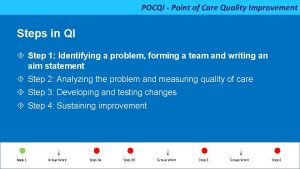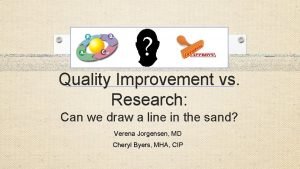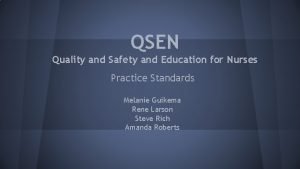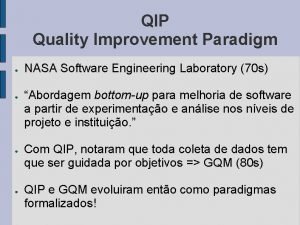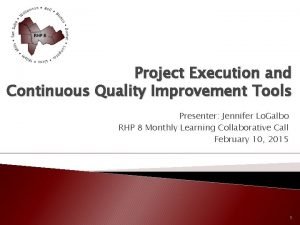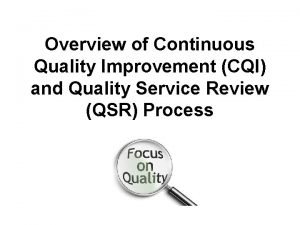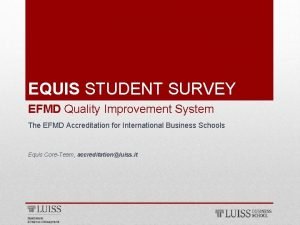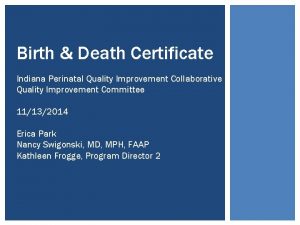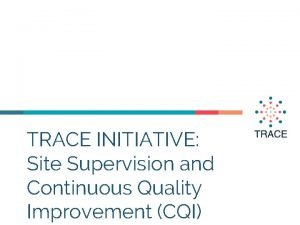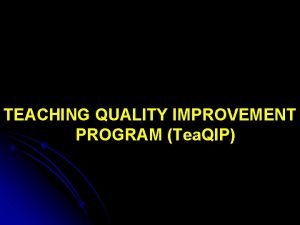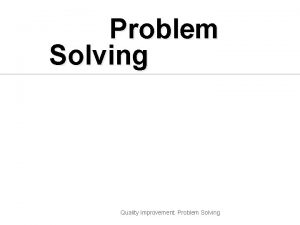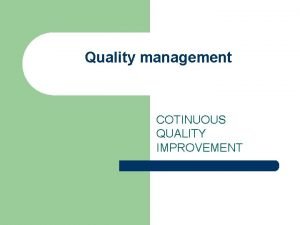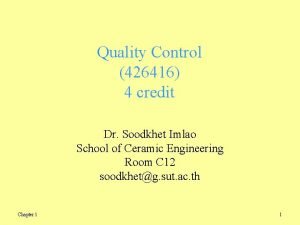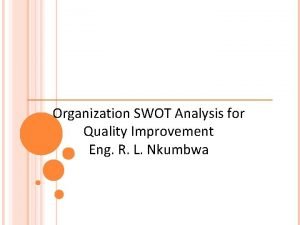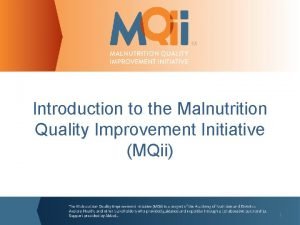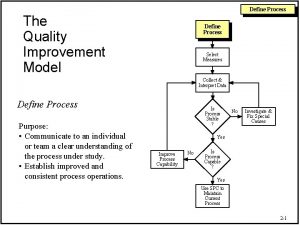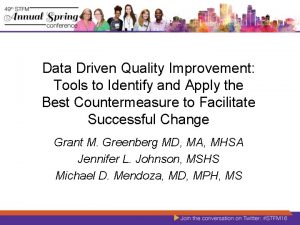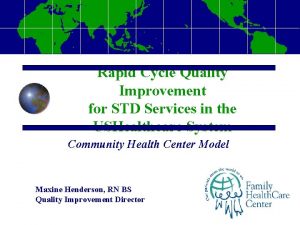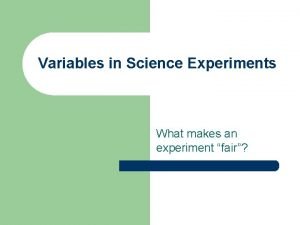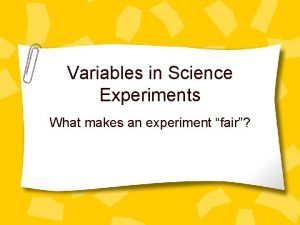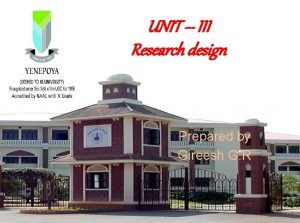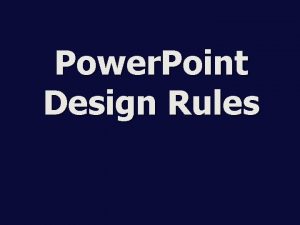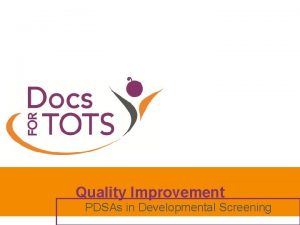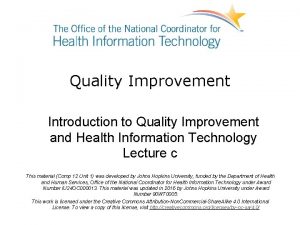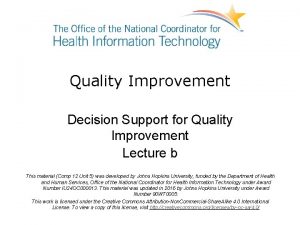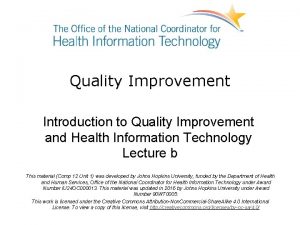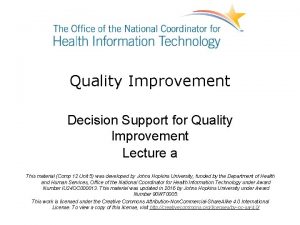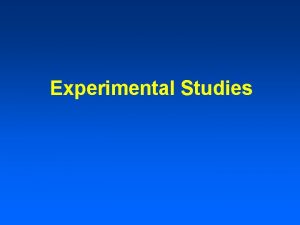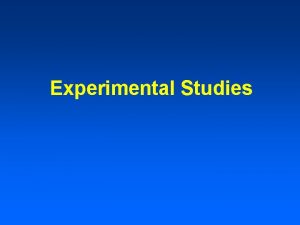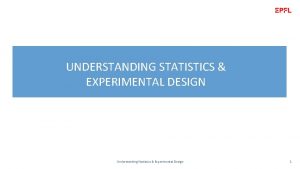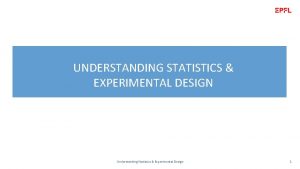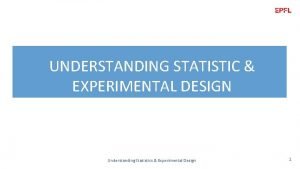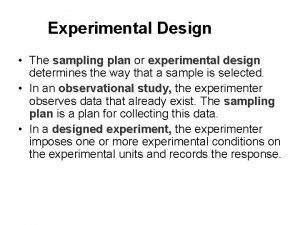Quality Improvement Chapter 13 Experimental Design Power Point


































- Slides: 34

Quality Improvement Chapter 13 - Experimental Design Power. Point presentation to accompany Besterfield, Quality Improvement, 9 e

Outline 1. Introduction 2. Basic Statistics 3. Hypotheses 4. t Test 5. F Test 6. One factor at a time 7. Orthogonal Design Quality Improvement, 9 e Dale H. Besterfield 2 Inc © 2013, 2008 by Pearson Higher Education, Upper Saddle River, New Jersey 07458 • All Rights Reserved

Outline 8. Point and Interval Design 9. Two Factors 10. Full Factorials 11. Fractional Factorials 12. Examples 13. Final Considerations Quality Improvement, 9 e Dale H. Besterfield 3 Inc © 2013, 2008 by Pearson Higher Education, Upper Saddle River, New Jersey 07458 • All Rights Reserved

Learning Objectives When you complete this chapter, you are expected to: q Know the applicable terminology; q Understand the concept of hypothesis testing; q Be able to determine significant factors using the t test; q Know the concept of point and interval estimate and be able to calculate them; q Be able to determine significant factors and their levels using the F test; q Understand the concept of fraction factorials. Quality Improvement, 9 e Dale H. Besterfield 4 © 2013, 2008 by Pearson Higher Education, Inc Upper Saddle River, New Jersey 07458 • All Rights Reserved

Introduction o Experimental design is a systematic manipulation of variables to make conclusions and implement results. o Goals are to determine : n n n The variable(s) and their magnitude that influences the response. The levels for these variables. How to manipulate these variables to control the response. o Experimental design should precede SPC Quality Improvement, 9 e Dale H. Besterfield 5 Inc © 2013, 2008 by Pearson Higher Education, Upper Saddle River, New Jersey 07458 • All Rights Reserved

Introduction (Continued) o Experimental design can be used to: n n n Improve a process by increasing performance Establish statistical control of a process Improve a product or develop a new product o Definitions for this chapter and next n n Factor– variable such as time, temp. , operator, etc Level—value assigned to a factor (50°F for temp) Treatment Condition (TC)—set of conditions (factor/levels) Replicate—repeat of TC with change in set up Quality Improvement, 9 e Dale H. Besterfield 6 Inc © 2013, 2008 by Pearson Higher Education, Upper Saddle River, New Jersey 07458 • All Rights Reserved

Definitions (Continued) n n Repetition—multiple results of a TC Random—TC are run in a random order Orthogonal Array—TC are put together so the design is balanced and factor/levels can be analyzed singly or in combination. Interaction—two or more factors that together produce results different than their separate effects Quality Improvement, 9 e Dale H. Besterfield 7 Inc © 2013, 2008 by Pearson Higher Education, Upper Saddle River, New Jersey 07458 • All Rights Reserved

Basic Statistics o See Chapter 5 o Variance is square of standard deviation & is also called the mean square MS, which is the sum or squares (SS) divided by the degrees of freedom (v) MS = SS/v SS = Ʃ (x – x)² v=n-1 Quality Improvement, 9 e Dale H. Besterfield 8 Inc © 2013, 2008 by Pearson Higher Education, Upper Saddle River, New Jersey 07458 • All Rights Reserved

Hypotheses o Hypotheses (Ho) testing is a statistical decision where inferences are made about the population from a sample. o Does or doesn’t the means of two samples from identical populations differ. Null hypothesis. Ho: μ 1 = μ 2 OR μ 1 - μ 2 = 0 Because, we are dealing with samples there is the risk of a Type I error (Null hypothesis is rejected when it is actually true) OR a Type II error (Null hypothesis is accepted when it is actually false). See Table 13 -1. Quality Improvement, 9 e Dale H. Besterfield 9 Inc © 2013, 2008 by Pearson Higher Education, Upper Saddle River, New Jersey 07458 • All Rights Reserved

Hypotheses (Continued) o Therefore, we use alternate hypothesis: n μ ǂ μ 2 Both tails of distribution n μ 1 > μ 2 Right tail of distribution n μ 1 < μ 2 Left tail of distribution o The consequences or risk (α) of making a decision are given in Table 13 -2. For example an α of 0. 01 is used where there might be a few lives lost Quality Improvement, 9 e Dale H. Besterfield 10 Inc © 2013, 2008 by Pearson Higher Education, Upper Saddle River, New Jersey 07458 • All Rights Reserved

t Test It is used when the sample size is small. The distribution is unimodal and will almost be identical with the normal at n = 30 Quality Improvement, 9 e Dale H. Besterfield 11 Inc © 2013, 2008 by Pearson Higher Education, Upper Saddle River, New Jersey 07458 • All Rights Reserved

t Test (Continued) Figure 13 -2 shows the critical region where t is the critical value, which is found in Appendix F for risk α and degrees of freedom v Quality Improvement, 9 e Dale H. Besterfield 12 Inc © 2013, 2008 by Pearson Higher Education, Upper Saddle River, New Jersey 07458 • All Rights Reserved

t Test (Continued) o One sample t test uses the equation: The calculated t value is compared to the critical t value. If the calculated value is in the critical region, the alternate hypothesis can not be rejected. See example problem Quality Improvement, 9 e Dale H. Besterfield 13 Inc © 2013, 2008 by Pearson Higher Education, Upper Saddle River, New Jersey 07458 • All Rights Reserved

t Test (Continued) o Two sample test Where: Quality Improvement, 9 e Dale H. Besterfield 14 Inc © 2013, 2008 by Pearson Higher Education, Upper Saddle River, New Jersey 07458 • All Rights Reserved

F Test o For more than 2 factors or levels the F test using the F distribution and ANOVA are used. Same analysis as for the t test. If the calculated F is larger than the critical F value the test is significant Quality Improvement, 9 e Dale H. Besterfield 15 Inc © 2013, 2008 by Pearson Higher Education, Upper Saddle River, New Jersey 07458 • All Rights Reserved

F Test (Continued) o Analysis of Variance (ANOVA) o Mathematical model of an experiment Quality Improvement, 9 e Dale H. Besterfield 16 Inc © 2013, 2008 by Pearson Higher Education, Upper Saddle River, New Jersey 07458 • All Rights Reserved

ANOVA (Continued) o Normal and independent distributed with same variance in each factor/level o Initial calculation equations for a spreadsheet are: Quality Improvement, 9 e Dale H. Besterfield 17 Inc © 2013, 2008 by Pearson Higher Education, Upper Saddle River, New Jersey 07458 • All Rights Reserved

Once you calculate the SS values the remaining calculations easy. Critical F value is obtained from Appendix C and if it is smaller than the F value the test is significant Quality Improvement, 9 e Dale H. Besterfield 18 © 2013, 2008 by Pearson Higher Education, Inc Upper Saddle River, New Jersey 07458 • All Rights Reserved

One Factor at a Time Design o Is not balanced (only one 2 in each column) o Effects Quality Improvement, 9 e Dale H. Besterfield 19 Inc © 2013, 2008 by Pearson Higher Education, Upper Saddle River, New Jersey 07458 • All Rights Reserved

Orthogonal Design o Orthogonal means balanced. Average factor/level. o A 1 = Results of TC, s (1+3+5+7)/4 o A 2 = Results of TC, s (2+4+6+8)/4 o B 1 = Results of TC, s (1+2+5+6)/4 o Etc. Quality Improvement, 9 e Dale H. Besterfield 20 Inc © 2013, 2008 by Pearson Higher Education, Upper Saddle River, New Jersey 07458 • All Rights Reserved

Orthogonal Design (Continued) o Design is statistically independent o Effect of A = A 2 - A 1 o Effect of B = B 2 - B 1 o Etc. o It is much more efficient. o Compare results of Ex 13 -5 (One Factor at a Time) to Ex 13 -6 Quality Improvement, 9 e Dale H. Besterfield 21 Inc © 2013, 2008 by Pearson Higher Education, Upper Saddle River, New Jersey 07458 • All Rights Reserved

Point and Interval Estimate o True value of a factor is rarely known, so an interval or range about a value is given. Quality Improvement, 9 e Dale H. Besterfield 22 Inc © 2013, 2008 by Pearson Higher Education, Upper Saddle River, New Jersey 07458 • All Rights Reserved

t Reference Distribution o t Reference Distribution uses the concept of interval estimate to determine which factor/levels are significant. Quality Improvement, 9 e Dale H. Besterfield 23 Inc © 2013, 2008 by Pearson Higher Education, Upper Saddle River, New Jersey 07458 • All Rights Reserved

Example 13 -8 Data from Example 13 -4 Quality Improvement, 9 e Dale H. Besterfield 24 © 2013, 2008 by Pearson Higher Education, Inc Upper Saddle River, New Jersey 07458 • All Rights Reserved

Two Factors q A simple experimental design has two factors and can have many levels as shown below; however, two levels are common and sometimes three levels. Each factor/level can have replications. Quality Improvement, 9 e Dale H. Besterfield 25 Inc © 2013, 2008 by Pearson Higher Education, Upper Saddle River, New Jersey 07458 • All Rights Reserved

Two Factors (Continued) ANOVA is the decision method and once the SS are calculated, the process leads to a decision using the F test. Quality Improvement, 9 e Dale H. Besterfield 26 Inc © 2013, 2008 by Pearson Higher Education, Upper Saddle River, New Jersey 07458 • All Rights Reserved

Full Factorials A 3 factor/2 level, with a + for the high level and a – for the low level is shown below. Signs for the 3 factors is as shown. Quality Improvement, 9 e Dale H. Besterfield 27 Inc © 2013, 2008 by Pearson Higher Education, Upper Saddle River, New Jersey 07458 • All Rights Reserved

Full Factorials (Continued) o Signs for the 2 factor and 3 factor interactions are based on the signs of the 3 factors in each TC. o Two factor nteraction signs are (- x - = +) (- x + = -) (+ x - = -) (+ x + = +) o Three factor interaction signs are (- x – x - = -) (- x + x - = +) (+ x + = +) (+ x - x + = -) Quality Improvement, 9 e Dale H. Besterfield 28 Inc © 2013, 2008 by Pearson Higher Education, Upper Saddle River, New Jersey 07458 • All Rights Reserved

Full Factorials (Continued) o ANOVA is the decision method and once the SS are calculated, the process leads to a decision using the F test. Quality Improvement, 9 e Dale H. Besterfield 29 Inc © 2013, 2008 by Pearson Higher Education, Upper Saddle River, New Jersey 07458 • All Rights Reserved

Full Factorials (Continued) The number of TC is determined by Thus for a 2 level design 2² = 4; 2³ = 8; 4 -16; 5 -32; etc for a 3 level design 3² = 9; 3³ = 27; 4 -81; etc Quality Improvement, 9 e Dale H. Besterfield 30 Inc © 2013, 2008 by Pearson Higher Education, Upper Saddle River, New Jersey 07458 • All Rights Reserved

Fractional Factorials q. The number of TC’s can become quite large. q. Use Engineering judgment to eliminate some interactions and substitute a factor Quality Improvement, 9 e Dale H. Besterfield 31 Inc © 2013, 2008 by Pearson Higher Education, Upper Saddle River, New Jersey 07458 • All Rights Reserved

Examples o Evans Clay o John Deere o Nabisco o Wilkes-Barre Hospital o Eastman Kodak o Farmington High School o K 2 Corporation o Hercules Corporation Quality Improvement, 9 e Dale H. Besterfield 32 Inc © 2013, 2008 by Pearson Higher Education, Upper Saddle River, New Jersey 07458 • All Rights Reserved

Implementation o Set good factor/levels and response variable o Replicate and random o Block out known or unwanted sources of variation such as environment o Evaluate interactions and make adjustments o Transfer lessons learned to other experiments o Confirm results with another experiment Quality Improvement, 9 e Dale H. Besterfield 33 Inc © 2013, 2008 by Pearson Higher Education, Upper Saddle River, New Jersey 07458 • All Rights Reserved

Computer Program o Microsoft EXCEL will calculate t distribution, F distribution, confidence and SS. Quality Improvement, 9 e Dale H. Besterfield 34 Inc © 2013, 2008 by Pearson Higher Education, Upper Saddle River, New Jersey 07458 • All Rights Reserved
 Non experimental design vs experimental
Non experimental design vs experimental Quality improvement vs quality assurance
Quality improvement vs quality assurance Compliance vs quality
Compliance vs quality Pocqi
Pocqi Experimental vs non experimental
Experimental vs non experimental What is quasi experimental research
What is quasi experimental research Disadvantages of experimental research
Disadvantages of experimental research Experimental vs non experimental
Experimental vs non experimental Jhm irb
Jhm irb Qsen project examples
Qsen project examples Quality improvement paradigm
Quality improvement paradigm Continuous quality improvement plan example
Continuous quality improvement plan example Define continuous quality improvement
Define continuous quality improvement Efmd quality improvement system
Efmd quality improvement system Indiana perinatal quality improvement collaborative
Indiana perinatal quality improvement collaborative Cqi action plan template
Cqi action plan template Tea quality improvement
Tea quality improvement Xerox problem solving process
Xerox problem solving process Sustainability in quality improvement
Sustainability in quality improvement Quality improvement nurse
Quality improvement nurse Quality improvement
Quality improvement Juran 10 steps to quality improvement
Juran 10 steps to quality improvement Swot analysis quality improvement
Swot analysis quality improvement Mqii toolkit
Mqii toolkit Quality improvement
Quality improvement Data driven quality
Data driven quality Rapid cycle quality improvement
Rapid cycle quality improvement Crosby's fourteen steps to quality improvement
Crosby's fourteen steps to quality improvement Draw power triangle
Draw power triangle Informsu
Informsu Point point power
Point point power Power point presentation design west vancouver
Power point presentation design west vancouver What is a dependent variable in science
What is a dependent variable in science Experimental design independent and dependent variables
Experimental design independent and dependent variables Characteristics of experimental research design
Characteristics of experimental research design



